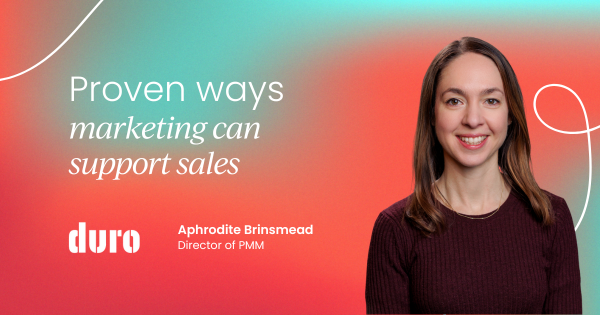In this article, I’m going to share some tactical approaches to creating more productive relationships with sales. I’ll also show how you can use those relationships to bolster the product marketing programs that you, your internal stakeholders, and your customers all care about.
Ready? Let's get started.
Establishing a personal connection with sales reps
To begin, let's take a look at the first way to build empathy with sales: the boots-on-the-ground approach. This sounds a bit tedious, but I promise it can be done.
I was employee number 60 at Quantum Metric, and we’ve since grown to 400. As you can imagine, we've hired more than a couple of salespeople along the way, but I still make the effort for myself or a member of my team to connect with every single seller, sales executive (SE), account executive (AE), and sales development representative (SDR) that comes through the door.
This is so important for building a relationship because it shows that we're approachable, we care about them and their success, and we want to understand their world.

Secondarily, if these folks are experienced sellers, they might already know a ton about our customers and our target audience. We need to get with them to understand where they've sold in the past, particularly if they’ve sold for a partner or a competitor.
Something as simple as a 15-minute chat over coffee means that this person will see product marketing as a valuable research resource that they can reach out to, and we’ll be able to do the same.
Beyond that, joining sales calls is a great way to learn about the challenges that sellers are dealing with. You can leverage tools like Gong to listen to a call every day and put yourself in the shoes of your sales folks and customers.
Lastly, it’s important to onboard new product marketers like AEs. Product marketers at Quantum Metric don't have the simplest onboarding program because it involves a ton of product, marketing, onboarding, sales, and solutions engineering knowledge, but that's vital because it builds the empathy we need to be successful and maintain those relationships.

Revenue enablement partnership
The other part of relationship building is all about partnering with your revenue enablement team. We're fortunate to have an incredible revenue enablement team here at Quantum Metric, and we do everything we can to support that team.
This means helping to craft onboarding content and running various onboarding sessions. That helps us put a face to the programs we care about, from customer stories to pricing and packaging to competitive analysis. This is crucial for point-in-time activities like launches, as well as ongoing enablement.
Let’s talk channels
We’ve done a little bit of the prep; now let's get cooking and talk about the tools of the trade: our channels.
As Quantum Metric was scaling, we saw that marketing and partner teams each had their own programs, and they were all hitting sales at once.
We soon realized we needed to create some reliable and predictable dedicated channels that would bring all these programs together and make it easier for sales to find and process the information they need to be successful.
With this in mind, we worked with our revenue enablement teams to create a weekly enablement newsletter where we consolidate all of our updates from freshly baked content to new events, product updates, and market intelligence and put it all into one email that's referenceable and searchable. We cross-post the newsletter to Slack as well.
We also have purpose-built Slack channels, which have been incredibly helpful. We have channels for outbound communication, where product marketing shares new content, programs, and pricing updates that sales needs to be aware of. We also have two-way channels, where we can have a dialogue with sales and have them drive the conversation.
Of course, it doesn't always work perfectly, but having channels with dedicated purposes (and referencing that in onboarding) helps to coordinate our efforts and make these channels more effective.
Finally, we have recurring enablement sessions in which we partner with the enablement team to share new product updates, market updates, and win-loss analyses.
We bring voices from the field into everything we do here, whether that’s an SE who ran a great demo or an AE who nailed how we differentiate against a certain competitor.
We're using those internal voices to drive the efficacy of our internal channels. That way, it's not just us grandstanding and saying what we think. Real voices from the field create more adoption from the go-to-market organization, and that is such a force multiplier for any program.
Building an effective feedback loop with sales teams
So we've got the fire burning nice and slow, but how do we know that the temperature is right and everything's cooking properly? It all comes back to the prep.
We’ve already established ourselves as approachable, so our salespeople will connect if they need us, and, crucially, they’ll share the feedback that lets us know whether we’re on track,
We do regular and recurring surveys to understand how our enablement content and programs are landing, as well as how our sales teams feel about things like more general things like pricing.
As we’re doing all of this, we need to remember that all feedback is good feedback. We're going to get a lot of it, and it's not all going to be actionable, but if we get it at a regular cadence, we can start to identify some trends and then, for instance, ramp up a certain channel or produce more of a certain piece of content.
It also helps us understand what's happening in the field and consequently what's happening with our customers.
How to drive adoption of your programs and content among sales teams
As I'm sure you know, PMMs are always selling, so when it comes to the programs you're putting out, just like with brisket, the ingredients matter. You can have a great grill, but if you don't have a good cut of beef, it doesn't really matter.
It's the same with your channels: they mean nothing without compelling content to put in them. We need our content and programs to get adopted. Let's talk about some of the ways that we can do that.
Whether it's a dedicated enablement session or just a couple of slides in an all-hands, we need to be passionate about what we're delivering and get people bought into the value that we provide.
In order for our programs to be valuable, they need to be perceived as valuable. That way, they’ll be adopted and distributed through the channels that drive business outcomes. So how do we hit the mark regarding adoption?
The first thing, as I mentioned before, is constantly gathering feedback. However, feedback is a two-way street. If we share a new piece of content collateral, create a new enablement session, or make an adjustment to a certain program, we highlight who helped us drive that decision, the feedback we got, and how important that is to us. We want to show how much that perpetual feedback loop matters.
Secondarily, we bring our sales teams into the messaging creation process. If you're putting together differentiated messaging to accompany a product launch or something along those lines, bring AEs and SEs in and ask them for their feedback. Sales is a great resource for that because they can help you understand the customer problem that your product is trying to solve and make that clear in the messaging.
Make sure they're at the table too when you're taking this program to internal audiences in enablement sessions. Having them involved is going to lend you so much credibility among your sales teams, and that’s going to help you drive adoption.
Crafting an environment of alignment
Everything I’ve talked you through so far is going to help you build a strong and productive relationship with your sales teams, but how can we make sure we sustain that? By creating an environment of alignment from the top down.
Sometimes your sales and marketing leaders might not be as aligned as you want them to be, so you have to push that alignment. This means those leaders can't care about vanity metrics or politics; they have to care about what impacts the customer.
Ideally, your top-line corporate objectives will get everybody aligned around revenue and customer value, and you can boil it down from there and get everyone working hand in hand.
So how do we get started with this? Well, the best way to look at it is as a throughline of corporate objectives. Connect those corporate objectives to the work your team does every day. You want to align your teams’ goals to your company’s OKRs for each period.
You can then boil those objectives down even further to the individual tasks that you or your team are doing each week. This means if, for instance, you're creating a new solution sheet, you can point to the corporate objective that that's supporting. That alignment is super important for getting sales and marketing to work together.
Time to wrap and review
Let’s wrap up with a few key takeaways:
- Build the foundation for a great relationship by getting to know your sales folks and making product marketing approachable.
- Develop reliable channels to deliver your programs to the field.
- Work with sales to create top-quality messaging and drive program adoption.
- Build top-level alignment between sales and marketing to create an environment for success.
As the late great Anthony Bourdain said:
“Barbecue may not be the road to world peace, but it’s a start.”
Get started. Take one of these tactics, do something tomorrow, next week, and then next quarter, and start on that road towards a great relationship with sales.
This article is based on a presentation from the Product Marketing Trailblazers event, from December 2021. Catch up using our OnDemand service. For more exclusive content, visit your member dashboard.


 Follow us on LinkedIn
Follow us on LinkedIn

